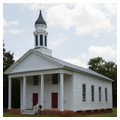The old Methodist Protestant Church, located near what was once the center of the village, dates to the 1830s, although its portico was likely added a few years after its construction. Its octagonal belfry sports an unusual, acorn-shaped roof probably derived from a plate found in the 1803 edition of William Pain’s The Carpenter’s Pocket Directory. Longstanding tradition holds that the belfry came from Alabama’s first statehouse (1819–1820) at Cahawba, and was transported via river and oxcart to Lowndesboro by slaves belonging to an early communicant, Major William Robinson. When the original congregation merged with its Methodist Episcopal counterpart in the 1870s, the building was sold to an African American congregation. Abandoned by the 1980s, it was purchased and restored by the Lowndesboro Heritage Society. Today it serves as a venue for special events.
References
Gamble, Robert. The Alabama Catalog – Historic American Buildings Survey: A Guide to the Early Architecture of the State. Tuscaloosa: University of Alabama Press, 1987.
Lowndesboro Heritage Society. Lowndesboro’s Picturesque Legacies. Privately printed, 1994.
Parker, Carolyn Smith. Harbingers of North Lowndes. Privately printed, 2016.








